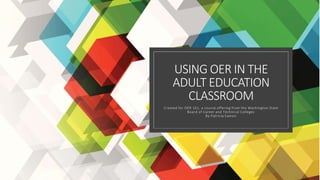Benefits and Challenges of Using OER in the Adult Education Classroom by Patricia Eamon.pptx
•Als PPTX, PDF herunterladen•
0 gefällt mir•11 views
This document discusses using open educational resources (OER) in adult education classrooms. It outlines key characteristics of adult learners and courses, which include goal-oriented learners with varied backgrounds and goals. It also lists benefits and challenges of using OER, such as increased access and variety versus difficulties finding and adopting appropriate resources. In conclusion, while adopting OER takes time, the benefits to students outweigh the challenges, and OER allows for worldwide collaboration between educators that could transform teaching and content creation.
Melden
Teilen
Melden
Teilen

Empfohlen
Empfohlen
Presentation by Stone Wiske at International Seminar e-Learning Around the World: Achievements, Challenges and Broken Promises.
CaixaForum, Barcelona. 7 June 2013.Stone Wiske. Teaching for Understanding: the role of ICT and e-Learning

Stone Wiske. Teaching for Understanding: the role of ICT and e-LearningeLearn Center (Universitat Oberta de Catalunya)
Weitere ähnliche Inhalte
Ähnlich wie Benefits and Challenges of Using OER in the Adult Education Classroom by Patricia Eamon.pptx
Presentation by Stone Wiske at International Seminar e-Learning Around the World: Achievements, Challenges and Broken Promises.
CaixaForum, Barcelona. 7 June 2013.Stone Wiske. Teaching for Understanding: the role of ICT and e-Learning

Stone Wiske. Teaching for Understanding: the role of ICT and e-LearningeLearn Center (Universitat Oberta de Catalunya)
Ähnlich wie Benefits and Challenges of Using OER in the Adult Education Classroom by Patricia Eamon.pptx (20)
Stone Wiske. Teaching for Understanding: the role of ICT and e-Learning

Stone Wiske. Teaching for Understanding: the role of ICT and e-Learning
Reaching More Learners Through Flipped Learning: Infusing Technology confere...

Reaching More Learners Through Flipped Learning: Infusing Technology confere...
FINAL-NLC-ORIENTATION-OF-SCHOOL-HEADS-PSDSs-TEACHERS (1).pdf

FINAL-NLC-ORIENTATION-OF-SCHOOL-HEADS-PSDSs-TEACHERS (1).pdf
Kürzlich hochgeladen
Kürzlich hochgeladen (20)
Food Chain and Food Web (Ecosystem) EVS, B. Pharmacy 1st Year, Sem-II

Food Chain and Food Web (Ecosystem) EVS, B. Pharmacy 1st Year, Sem-II
Web & Social Media Analytics Previous Year Question Paper.pdf

Web & Social Media Analytics Previous Year Question Paper.pdf
Ecological Succession. ( ECOSYSTEM, B. Pharmacy, 1st Year, Sem-II, Environmen...

Ecological Succession. ( ECOSYSTEM, B. Pharmacy, 1st Year, Sem-II, Environmen...
ICT Role in 21st Century Education & its Challenges.pptx

ICT Role in 21st Century Education & its Challenges.pptx
Z Score,T Score, Percential Rank and Box Plot Graph

Z Score,T Score, Percential Rank and Box Plot Graph
Measures of Dispersion and Variability: Range, QD, AD and SD

Measures of Dispersion and Variability: Range, QD, AD and SD
Seal of Good Local Governance (SGLG) 2024Final.pptx

Seal of Good Local Governance (SGLG) 2024Final.pptx
Python Notes for mca i year students osmania university.docx

Python Notes for mca i year students osmania university.docx
On National Teacher Day, meet the 2024-25 Kenan Fellows

On National Teacher Day, meet the 2024-25 Kenan Fellows
Mixin Classes in Odoo 17 How to Extend Models Using Mixin Classes

Mixin Classes in Odoo 17 How to Extend Models Using Mixin Classes
Benefits and Challenges of Using OER in the Adult Education Classroom by Patricia Eamon.pptx
- 1. USING OER IN THE ADULT EDUCATION CLASSROOM Created for OER 101, a course offering from the Washington State Board of Career and Technical Colleges By Patricia Eamon
- 2. Some key characteristics of Adult Education students and courses Adult learners: ◦ Are often highly goal-oriented. ◦ Bring a multitude of real-world skills and experiences to their work. ◦ Learn best when presented with highly contextualized content. ◦ Learn best when academic work is relevant to their experiences and goals. ◦ May have had negative learning experiences in the past or have developed negative self- perceptions about their intelligence or ability. The adult education classroom often combines students who are pursuing widely varying academic and career goals: ◦ GED ◦ High School + ◦ English Language Learning ◦ College skills development ◦ Career/Technical education/training
- 3. Benefits of using Open Educational Resources in the Adult Education classroom: ◦ Equity/Access: Students do not have to purchase expensive textbooks. ◦ Variety: I am able to offer students a wider variety of educational content, not being restricted to using one or two textbooks. ◦ Quality: OER helps me to offer resources from educators who are interested in educational equity/access, best practices, and collaboration. ◦ Relevance: Some Open Educational Resources can be adapted or edited by myself or other users, increasing their timeliness and relevance. ◦ Critical Thinking/Collaboration: Students may be invited to participate in innovating upon, expanding, or otherwise altering open educational resources, activities that encourage critical thinking and collaboration.
- 4. Challenges when using Open Educational Resources in the Adult Education classroom: ◦ Locating Appropriate Resources: It can be difficult/time-consuming to find resources that are appropriate to the multi- level/multi-goal courses I teach. ◦ Adoption/Attribution: It can be difficult/time-consuming to determine how to present and correctly attribute resources. ◦ Technology: Some resources are in formats/on platforms that are difficult to integrate into the formats/platforms I use when teaching. ◦ Quality: Not all open education resources are created equal, and without the assurance provided by a formal review and editing process, some resources may include inaccuracies. ◦ Maintenance of Resources/Sites: Some OER repositories have broken or corrupted links and are not continually monitored for these, making the process of finding good resources somewhat more difficult.
- 5. In summation: ◦ The potential of OER will take some time to fully realize, as educators learn how to locate and integrate OER into their course and as the number of resources in various disciplines and the sites that offer them expand. ◦ The benefits to students in terms of access, relevance, quality, and collaboration outweigh the challenges of finding and adopting resources. ◦ OER presents the possibility of world-wide collaboration between educators, researchers, writers, and students, which will in time (hopefully) mean that more educators are situating their own teaching, research, and content creation in a more diverse, interconnected, and global context. ◦ The effects of this greater interconnectedness and diversity on disciplinary assumptions and gatekeeping could be extraordinary.